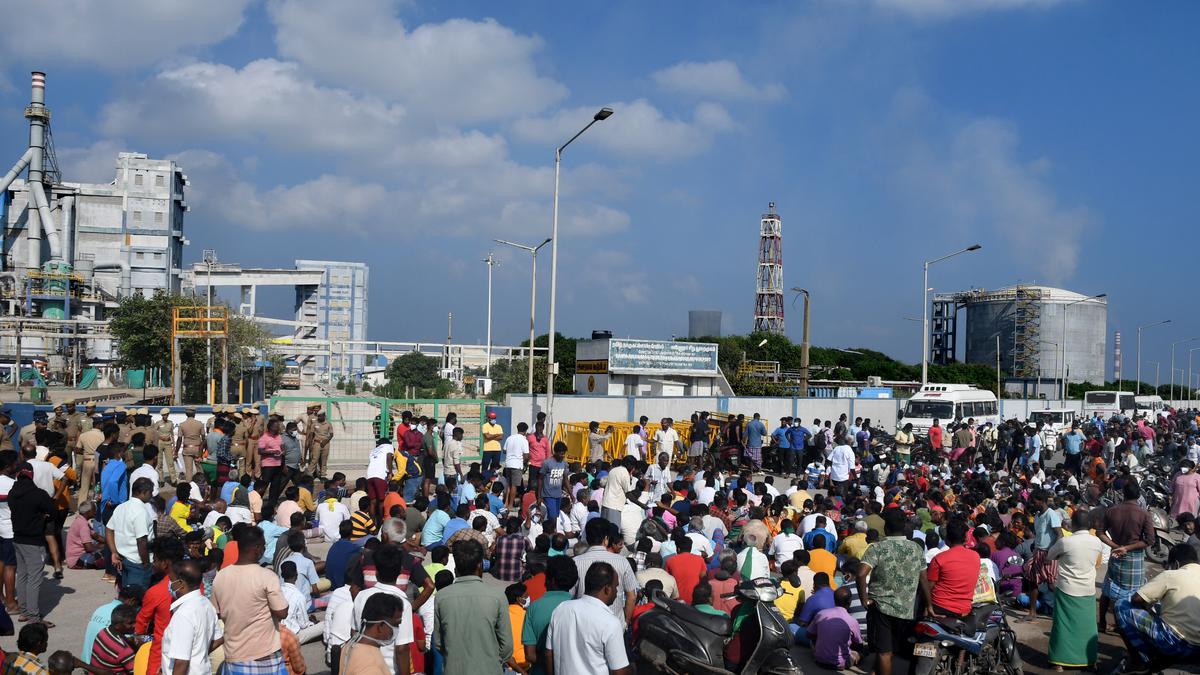
Ennore goes to battle again
The Hindu
Residents of Ennore grapple with effects of ammonia leak, causing panic & health risks in the area.
As residents of Ennore in north Chennai drew the curtains on December 26, they had no clue to the impending period of panic that was to hit them soon, mere weeks after they grappled with the effects of an oil spill. At Periyakuppam, when Doulath Begum, 27, went to the bathroom some time after 11 p.m., she sensed a strange pungent odour. Her husband, K. Balachandar, 34, said it could be the mosquito repellent they had lit up. As she insisted that the odour was coming in through the ventilator, he opened their front door ajar to a strong gush of pungent ammonia, a smell they were far too familiar with.
At the same time, one of the workers leaving the nearby factories — the workers being the first to breathe in ammonia and quickly alert locals — began banging on Mr. Balachandar’s door, yelling about a ‘tank burst’. So, he immediately tied a damp cloth around his nose and rushed out with his wife and child. They came onto the streets to find chaos.
No tank had ‘burst’. But, around 11.30 p.m. on December 26, there was a leak in the ammonia unloading pipelines of Coromandel International Limited, a fertiliser manufacturing unit at Ennore, about 2 feet from the shore, according to an official statement released the next day. When the pipelines are not in use, they are maintained at 2 kg/cm2 vapour pressure. Thirty-six hours before the transfer of ammonia, which the company receives in a 3,000-8,000-tonne monthly shipment, the pipeline is put through a pre-cooling process. During this process, gas bubbles rose out of the subsea pipeline, spreading the stench.
Without any information as to what was happening, hundreds of residents living close to the unit assumed the worst and started moving out of their homes towards Thiruvottiyur. “When we came outside, the smell was so strong that it immediately caused a choking sensation,” says Vijaya, a resident of Chinnakuppam.
By 12.30 a.m., the district authorities and the police were alerted. A couple of government buses came to ferry residents out and the police told people that it was only a leak, which was fixed. Hundreds of people stayed at a community hall near the office of Thiruvottiyur MLA K.P. Shankar until the next morning. Fifty-two people were admitted to hospital as they experienced breathing difficulties.
According to a statement from the Tamil Nadu Pollution Control Board (TNPCB), a message was received from the unit at 12.45 a.m. Reaching the site at 2.15 a.m., officials of the TNPCB and the Directorate of Industrial Safety and Health (DISH) learnt that the unit immediately started depressurising the pipeline by diverting the ammonia vapour to the flare and completed the operation within 20 minutes.
Though those admitted to hospital have been discharged since, the impact on the environment must be studied. At 3.49 a.m. ammonia in the sea was 10 times the allowed level, with 49 mg/litre, as against the marine discharge standard of 5 mg/litre. In the air, near the pipeline leak area, at 3.51 a.m. the TNPCB measured it to be 3 ppm (2090 microgram/m3 as against 400 microgram/m3 on a 24-hour average) — five times the allowed level. From 4.02 a.m. to 4. 24 a.m., officials recorded the levels moving southwards from Thalankuppam to Periyakuppam, Chinnakuppam, Ernavurkuppam, Kathivakkam Railway Bridge, Ennore Gulf Oil gate, and Ennore bus depot — all measuring 0 ppm.













